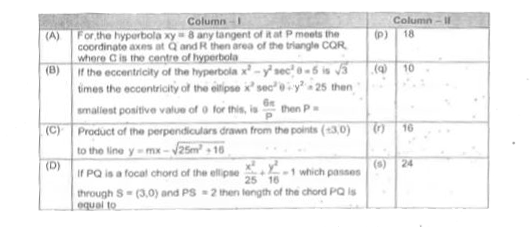If t be any non-zero number , then the locus of extremities of the family of hyperbolas . t2x2−y2=a2t2 is/are
x2=a2+ay
y2=a2+ax
x2=a2−ay
y2=a2−ax
The correct Answer is:A, C
To find the locus of the extremities of the family of hyperbolas given by the equation t2x2−y2=a2t2, we can follow these steps:
Step 1: Rewrite the Equation
Start with the given equation:
t2x2−y2=a2t2
Rearranging gives:
t2x2=y2+a2t2
Step 2: Divide by a2t2
To standardize the equation, divide both sides by a2t2:
t2x2a2t2−y2a2t2=1
This simplifies to:
x2a2−y2a2t2=1
Step 3: Identify the Parameters
From the standard form of the hyperbola, we can identify:
- The semi-major axis a
- The semi-minor axis b=at
Step 4: Find the Locus of Extremities
The extremities of the hyperbola occur at y=0. Substitute y=0 into the equation:
x2a2−0=1⟹x2=a2⟹x=±a
Thus, the extremities are at the points (a,0) and (−a,0).
Step 5: Generalize for All t
Since t is a non-zero parameter, we can express the locus of these extremities as:
x2=a2+a2t2
This can be rewritten as:
x2=a2(1+t2)
Let k=1+t2, then:
x2=a2k
This indicates that as t varies, the locus of the extremities forms a parabola.
Final Equation
Thus, the locus of the extremities of the family of hyperbolas is given by:
x2=a2+aky
This is the equation of a parabola.
Start with the given equation:
t2x2−y2=a2t2
Rearranging gives:
t2x2=y2+a2t2
To standardize the equation, divide both sides by a2t2:
t2x2a2t2−y2a2t2=1
This simplifies to:
x2a2−y2a2t2=1
From the standard form of the hyperbola, we can identify:
- The semi-major axis a
- The semi-minor axis b=at
The extremities of the hyperbola occur at y=0. Substitute y=0 into the equation:
x2a2−0=1⟹x2=a2⟹x=±a
Thus, the extremities are at the points (a,0) and (−a,0).
Since t is a non-zero parameter, we can express the locus of these extremities as:
x2=a2+a2t2
This can be rewritten as:
x2=a2(1+t2)
Let k=1+t2, then:
x2=a2k
This indicates that as t varies, the locus of the extremities forms a parabola.
Thus, the locus of the extremities of the family of hyperbolas is given by:
x2=a2+aky
This is the equation of a parabola.
Topper's Solved these Questions
- HYPERBOLABook:FIITJEEChapter:HYPERBOLAExercise:COMPREHENSIONS
Explore 9 Videos
- HYPERBOLABook:FIITJEEChapter:HYPERBOLAExercise:MATCH THE COLUMN
Explore 6 Videos
- HYPERBOLABook:FIITJEEChapter:HYPERBOLAExercise:ASSIGNMENT PROBLEMS ( OBJECTIVE) Level - I
Explore 47 Videos
- HEIGHTS & DISTANCE Book:FIITJEEChapter:HEIGHTS & DISTANCE Exercise:ASSIGNMENT PROBLEMS (OBJECTIVE) LEVEL-II
Explore 20 Videos
- INDEFINTE INTEGRALBook:FIITJEEChapter:INDEFINTE INTEGRALExercise:EXERCISE-8
Explore 1 Video
Similar Questions
If the coinc ax2+2hxy+by2+2gx+2fy+c=0 be a hyperbola , and the equation of the conjugate hyperbola is ax2+2hxy+by2+2gx+λ=0, then λ is equal to
View SolutionMatch the following :

View SolutionThe equation to the hyperbola of given transverse axis 2a along x- axis and whoe vertex bisects the distance between the centre and the focus is
View SolutionThe height of a house subtends a right angle at the opposite street light. The angle of elevation of light from the base of the house is 60∘. If the width of the road be 6 meters, then the height of the house is
View SolutionIntegrate the following:
∫dx5−13sinx
(ii) ∫dx13+3cosx+4sinx
(iii) ∫dxa2−b2cos2x(a2>b2)
(iv) ∫dxa2−b2cos2x(a2<b2)
(v) ∫sin2x+sin4x−sin6x1+cos2x+cos4x+cos6xdx
View SolutionThe locus represented by x=(a)/(2)(t+(1)/(t)),y=(a)/(2)(t-(1)/(t)) is
View SolutionThe locus of point ((e^(t)+e^(-t))/(2),(e^(t)-e^(-t))/(2)) is a hyperbola with eccentricity
View SolutionThe locus of the point x=(t^(2)-1)/(t^(2)+1),y=(2t)/(t^(2)+1)
View SolutionShow that the locus represented by x=12a(t+1t),y=12a(t−1t) is a rectangular hyperbola.
View SolutionShow that the locus represented by x=12a(t+1t),y=12a(t−1t) is a rectangular hyperbola.
View SolutionThe locus represented by x=a2(t+1t),y=a2(t−1t) is
View SolutionThe locus of the represented byx=t2+t+1,y=t2−t+1 is
View SolutionThe eccentricity of the hyperbola x=a2(t+1/t),y=a2(t−1/t) is
View SolutionThe locus of the point (et+e−t2,et−e−t2) is a hyperbola of eccentricity
View SolutionShow that the locus represented by x=12a(t+1t),y=12a(t−1t) is a rectangular hyperbola. Show also that equation to the normal at the point 't' is xt2+1+yt2−1=at.
View SolutionPoint ((e^t+e^(-t))/(2),(e^t-e^(-t))/(2)) The locus of is a hyperbola that has a focus
View Solution
